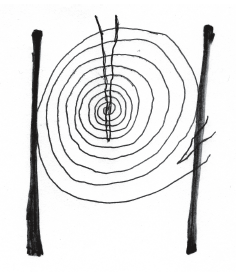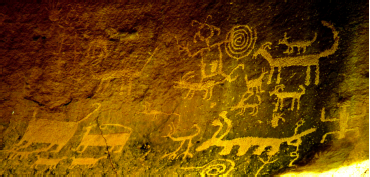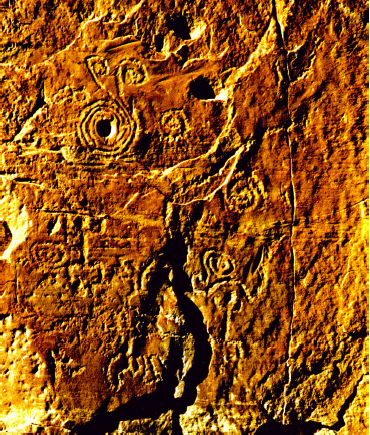|
This Fajada Butte Spiral is proposed to be a basic astronomical
alignment in the PBS special “The Mysteries of Chaco
Canyon” which demonstrates the advanced knowledge of
celestial events involving the sun and moon by the Chacoan
Anasazi.
From Tarahumara ethnographic evidence, does this symbol
also have a specific religious meaning that can be deduced to
be the fundamental “Rosetta Stone” to unraveling the mystery
of Chacoan religion? My research indicates that it does.
Can you unravel the mystery and perhaps the extended
significance of this symbol from the following clues?
1) What is the gender of the sun and dagger?
2) What is the gender of the moon, spiral, and two parallel
brackets?
3) How many months in the human gestation period?
4) How many rings are in this spiral?
5) Is there an entry “dagger” into the beginning of the
spiral?
The above questions are easily answered from basic human
knowledge and observation. The following are possible extensions
of this proposal, which are not readily observable or
known but are explained in the PBS program “The Mystery of
Chaco Canyon” and might be considered as one major
component of the ancient knowledge of the Chaco Canyon
Anasazi. Could this proposal be the “Chacoan proof ” that their
religious beliefs were observable, factually correct, and therefore
they held the keys to the “right religious beliefs?”
1) How long is half a moon cycle? (approximately 9 years)
2) How long is a complete moon cycle? (approximately 18
years)
3) Optimal reproduction age in human beings? (approximately
one moon cycle)
4) Onset of puberty in human females in tribal cultures?
(approximately 1/2 moon cycle)
5) From the bone record life-span of the average Anasazi? (2
full moon cycles)
From my research, this analysis integrates into other known
reigious artifacts such as the Scarlet Macaw. If the spiral indicates
female as is suggested for the Fajada
Butte Spiral Sun Dagger Petroglyph then it might be possible
to decode some of the Chaco Anasazi Petroglyphs in other
areas of the canyon. The above photograph has a number of
prominent spirals and also humanoid figures with “long”
tails. These tails may actually represent phallic male figures. In
the above glyph we can see a phallic male in association with
a spiral issuing forth to smaller spirals, which may represent
the birth of twin daughters. There is an associated spiral
issuing from the primary spiral which may indicate a previous
daughter. Below maybe a very typical hunting scene. The
humanoid figure is most likely a female and perhaps a
pregnant female. The bighorn sheep may indicate the Chaco
Anasazi awareness that a new supply of dietary iron was critical
to a successful pregnancy. These ideas at present are being
researched in the context of other Chacoan petroglyphs.
|


